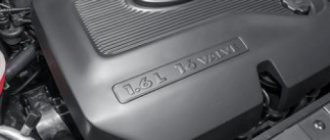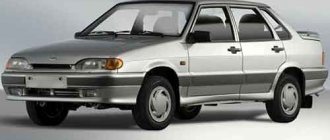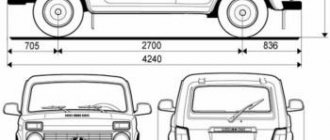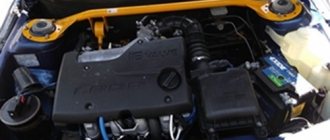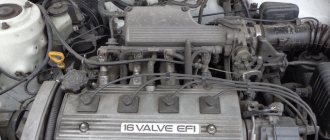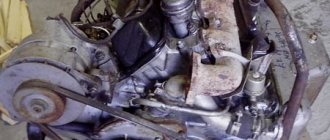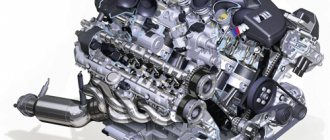Engine 2111 (in everyday life the designation 2114 is sometimes found) is an analogue of the famous VAZ engine 21083, which uses an injector instead of a carburetor.
Subsequently, a number of 1.5-liter engines were developed on its basis (2112, 21124, 21126, 21127, 21114, 21116). Combined with a gearbox and clutch, the VAZ 2111 engine is located in the engine compartment of the car on support cushions.
Application and general characteristics of the engine
Unit 2111 could be installed on the entire line of Lada Samara models, starting from 2108 to 2115, as well as on the “ten” and its modifications (2110-2112).
The working cycle of the VAZ 2111 engine (injector) is classic, that is, it is carried out in four strokes. Fuel is supplied to the combustion chamber through nozzles. The cylinders are arranged in one row. The camshaft is mounted on top. The internal combustion engine is cooled by force using a closed liquid system, and the parts are lubricated by a combined lubrication system.
What cars was it used in?
The 2111 engine was installed on the following models of front-wheel drive VAZ cars:
- 2108 – three-door hatchback;
- 21083 – three-door hatchback;
- 2109 – five-door hatchback;
- 21093 – five-door hatchback;
- 21099 – sedan;
- 2113 – three-door hatchback;
- 2114 – five-door hatchback;
- 2115 – sedan;
- 2110 – sedan;
- 2111 – five-door station wagon;
- 2112 – five-door hatchback.
The engine was installed on the “eights” and “nines” after 1987, respectively.
Technical characteristics of the VAZ-2111 injection engine
- Number of cylinders (pcs.) – 4.
- Number of valves (total) – 8 pcs. (two for each cylinder).
- Working volume – 1490 cm3.
- The compression value is 9.8.
- Power at crankshaft speed 5400 rpm. – 77 l. s., or 56.4 kW.
- The minimum possible crankshaft frequency at which the engine continues to operate stably is 750-800 rpm.
- The diameter of one cylinder is 82 mm.
- The length of the vertical stroke of the piston is 71 mm.
- Torque (maximum) – 115.7 Nm (at 3 thousand rpm).
- The order of ignition of the mixture in the cylinders is standard: 1-3-4-2.
- Recommended fuel type is AI-95.
- The recommended type of spark plugs is A17 DVRM or their analogues, for example, BPR6ES (NGK).
- Motor weight excluding technical. liquids – 127.3 kg.
Motor repair
A major overhaul of a VAZ 2110 engine means restoring the engine and its components to factory standards. This operation is carried out when the motor has passed its service life and there is exhaustion in the main components.
Due to the fact that the engines have been in use for a long time, some engines are 10-15 years old, a major overhaul is inevitable. So, the combustion chambers have already worn out, and the pistons have burned out from service life and mileage. In addition, engine oil for the VAZ 2110 no longer helps to maintain performance to such an extent.
So, it is worth repairing the power unit at a car service center, especially with regard to the 16-valve engine. The VAZ 2110 8-valve engine is used by most motorists in garage conditions, since it has a simple design that is similar to the Classic and Samara power units.
Location under the hood of the car
The 2111 engine, together with the gearbox and clutch mechanism, forms a single power unit, which is mounted on three rubber-metal supports in the engine compartment of the car.
To the right (if you look in the direction of movement of the car) from the cylinder block there is a set of drives: a crankshaft, a camshaft, and a pump for pumping antifreeze through the cooling system. The drives are made in the form of toothed pulleys connected by one belt. A generator is installed on the same side, which is also connected to the crankshaft pulley via a poly-V-belt.
A thermostat with a temperature sensor is mounted on the left side of the cylinder block.
The starter is located at the bottom of the front part. Between it and the generator there is an ignition module, from which high-voltage wires go to the spark plugs. There (to the right of the module) a dipstick is installed, immersed in the engine crankcase, for manual control of the oil level.
At the rear of the BC there is a receiver with a fuel rail and injectors, just below there is an oil filter, as well as intake and exhaust manifolds.
Malfunctions
The VAZ 2111 power unit is characterized by all the typical faults that are characteristic of the VAZ “classic”. For example:
| FAULT | CAUSE | SOLUTION METHOD |
| The thermal conditions of the engine are violated. | 1. The thermostat is faulty. 2. The coolant temperature sensor has failed. | Unusable components must be dismantled and replaced with new ones. |
| Extraneous knocks and noises during operation of the power unit. | 1. Valve clearances are broken. 2. The crankshaft main bearings are worn out. 3. The connecting rod bearings are worn out. 4. The pistons started knocking. | Adjust valve clearances. Replacement of parts associated with disassembling the motor must be carried out at a specialized service station. |
| The operating modes of the power unit are violated (the speed “floats”, “troits”, etc.). | 1. The throttle position sensor has failed. 2. The valve has burned out. 3. The gasket is broken. 4. Defect in the ignition system. | Ÿ Replace the faulty sensor. Ÿ The malfunction can be determined by measuring the compression in the cylinders. If in one of the cylinders it is below normal, then the valve has burned out, and if it is normal, the defect must be looked for in the ignition system. |
Features of the 2111 engine cylinder block (injector, 8 valves)
First of all, you can distinguish the model 2111 cylinder block from the 21083 block by the additional holes used to attach the generator bracket, as well as the ignition module and knock sensor.
The bolt holes for mounting the block head have a thread size of M12 x 1.25. The height of the block, if we take the distance from the crankshaft axis to the platform on which the cylinder head is installed as this value, is 194.8 cm. The original cylinder diameter is 82 mm, but repair boring can be carried out by 0.4 mm or 0.8 mm. The maximum wear of the “mirror” (surface) of the cylinder should not be more than 0.15 mm.
The 2111 engine has a crankshaft mod. 2112-1005015. It is identical in seating to the 2108 shaft, but its counterweights are larger and have undergone additional factory processing to significantly reduce rotational vibration and improve overall reliability.
Service
VAZ 2110 engines are serviced quite typically. Thus, scheduled maintenance is carried out within 10-15 thousand kilometers. If the vehicle is operated on LPG, then maintenance must be reduced to 8-10 thousand km in order to preserve the engine and extend its service life.
When servicing, it is necessary to pour only high-quality oils into the VAZ 2110 engine. Thus, there are a number of lubricating fluids that must be poured into the engine.
Do not forget about using a high-quality oil filter, which will also affect the service life. The power unit maintenance scheme is quite simple, and is provided by AvtoVAZ in the repair manuals.
The VAZ 2110 8 valve engine is quite unpretentious in the use of oil. So, both semi-synthetic and synthetic lubricant are ideal for him. Many car enthusiasts ask the question: how much oil should be poured into the engine? Almost all engines require 3.5 liters of oil.
Pistons and connecting rods
The dimensions of the 2111 engine pistons (injector) are similar to those installed on the 21083 and also have a shockproof recess on the bottom, ensuring the safety of the valves if the timing belt breaks.
The difference lies in special grooves for the circlips, which prevent the piston pin from moving. The finger itself differs from that used on model 2108. If the outer diameter remained the same, that is, 22 mm, then the inner diameter was reduced to 13.5 mm (it was 15). In addition, it was shortened slightly - by 0.5 mm (60.5 mm).
The size of the piston rings was not modified - 82 mm, but the connecting rod was redesigned: its lower head became more massive, the profile changed, and a more durable alloy resistant to mechanical stress was used for its manufacture.
The length of the connecting rod is 121 cm.
Tuning
According to the conclusion of specialists professionally involved in tuning power units, increasing the power of engines of the VAZ 2111 family is possible in several ways:
- Increasing engine power by installing a compressor
One of the most effective ways to increase the power characteristics of the 2111 power unit is to install a compressor that can provide a pressure of 0.5 bar. In this case, it is necessary to replace the installed camshaft with a Nuzhdin 10.42 or Nuzhdin 10.63 shaft and, by correctly setting the ECU, achieve an increase in power to 120 hp. With.
- You can increase the power of the power unit without using a compressor
To do this, you need to dismantle the existing camshaft and install instead an OKB Dinamika 108 or Nuzhdin 10.93 shaft with a split gear. After adjusting the phases, the engine power will increase to 85 hp. With. If you then install a receiver, replace the existing throttle valve with a larger one (diameter 54 mm), and install a “4-2-1 spider” instead of the exhaust manifold, you can achieve an increase in power to 95 hp. With. At the same time, the acceleration dynamics of the car will improve slightly.
By modifying the cylinder head and intake manifold by milling, as well as installing lightweight valves, we obtain a power of more than 100 hp. With.
- Another way to increase the power of the 2111 engine is to replace the 8-valve cylinder head with a 16-valve cylinder head with a receiver, an enlarged throttle valve (54 mm) and the organization of an exhaust gas exhaust system on a pipe with a diameter of 51 mm. This makes it possible to obtain power in the range of 105...110 hp. With.
Cylinder head
The cylinder head of the 2111 injection engine is the same as that installed on the 21083 model, there is only one difference - the head mounting bolts are longer.
The camshaft is similar to 2110. Its landing dimensions are the same as the shaft from 2108, but the profile of the cams is slightly different, which is why the lift of the valves has increased: intake - 9.6 mm, exhaust - 9.3 mm (on 2108, both were raised by 9 mm). In addition, the angles of inclination of the cams relative to the groove into which the cylinder head drive belt pulley key is installed were changed.
Thanks to the changes made, the manufacturer was able to improve the performance of the 2111 engine.
As for the timing drive, it is structurally the same as on 21083. The belt (19 mm wide) has 111 teeth with an involute profile.
Modifications
| Name | Year of issue | |
| LADA 111 (2111) 1.5 | 01.1996 — 12.2005 | Characteristics |
| LADA 111 (2111) 1.5 16V | 01.1995 — 08.2002 | Characteristics |
| LADA 111 (2111) 1.5 | 10.2000 — 12.2005 | Characteristics |
| LADA 111 (2111) 1.5 16V | 10.2000 — 12.2005 | Characteristics |
| LADA 111 (2111) 1.6 | 09.2004 — 12.2013 | Characteristics |
| LADA 111 (2111) 1.6 | 09.2004 — | Characteristics |
Other engine features
Due to the fact that after updating the engine, the torque in it increased, the design of the flywheel was also changed: the surface for the clutch increased from 196 to 208 mm, the width of the crown also increased to 27.5 mm (the previous one was 20.9), in addition, the size and shape of its teeth have changed.
The starter is the same as the 2110, which has a 9 tooth drive gear instead of 11 teeth.
This power unit is equipped with a 2112 oil pump, the only difference from the 2108 model is that the housing cover is made of aluminum, onto which the crankshaft sensor is mounted.
The water pump as part of the cooling system is the same as on the 2108.
The generator is marked 9402 3701 (80 A).
The engine is controlled by an electronic unit (ECU). Controllers (Bosch, GM or “January”) are suitable for this role.
Description
In 1994, engineers of the AvtoVAZ concern developed another engine of the tenth family, which received the VAZ-2111 index. For a number of reasons, it was possible to start its production only in 1997. During the production process (until 2014), the engine was modernized without affecting its mechanical part.
The VAZ-2111 is an in-line four-cylinder naturally aspirated petrol engine with a volume of 1.5 liters and a power of 78 hp. s and torque 116 Nm.
The VAZ-2111 internal combustion engine was installed on Lada cars:
- 21083 (1997-2003);
- 21093 (1997-2004);
- 21099 (1997-2004);
- 2110 (1997-2004);
- 2111 (1998-2004);
- 2112 (2002-2004);
- 2113 (2004-2007);
- 2114 (2003-2007);
- 2115 (2000-2007).
The engine is designed on the basis of the VAZ-2108 engine and is an exact copy of the VAZ-2110 with the exception of the power system.
The cylinder block is cast from high-strength cast iron, not lined. The cylinders are bored into the body of the block. The tolerance includes two repair sizes, i.e., it allows for two major repairs with cylinder boring.
The crankshaft is made of special cast iron and has five bearings. A special feature is the modified shape of the shaft counterweights, due to which they act as a balancing mechanism (dampen torsional vibrations).
The connecting rods are steel, forged. A steel-bronze bushing is pressed into the upper head.
Aluminum alloy pistons, cast. The piston pin is a floating type and is therefore secured with retaining rings. Three rings are installed on the skirt, two of which are compression and one is oil scraper.
The cylinder head is aluminum, with one camshaft and 8 valves. The thermal gap is adjusted by manually selecting shims, since hydraulic compensators are not provided.
The camshaft is cast from cast iron and has five bearings.
Timing belt drive. If the belt breaks, the valves do not bend.
Power supply system – injector (distributed fuel injection with electronic control).
Combined lubrication system. Gear type oil pump.
The cooling system is liquid, closed type. The water pump (pump) is of a centrifugal type, driven by a timing belt.
Thus, the VAZ-2111 fully complies with the classic design scheme of VAZ internal combustion engines.
Reviews from car owners about the model 2111 engine
As most car owners whose cars are equipped with the 2111 engine note, in general the unit is quite reliable: despite the fact that its working life, declared by the manufacturer, is 250 thousand km, in fact, subject to regular maintenance, the use of high-quality fuel and technical fluids its resource can be extended to 350 thousand km.
However, despite the transformations carried out, this engine inherited the disadvantages of previous models (21083 and 2110):
- requires periodic valve adjustment;
- rapid failure of individual elements of the cooling system, in particular the water pump;
- problem with oil leakage from the valve cover gasket;
- failure of the submersible fuel pump.
- breakage of the studs on the exhaust manifold at the place where the exhaust pipe is attached.
You can get rid of the last drawback by replacing the steel (factory) studs with brass ones.
And in conclusion: the 2111 engine, the price of which in Russia is about 60 thousand rubles, is a fairly popular model, and often the owners of VAZs, which also have carburetor engines, independently changed them to an injection engine.
Maintenance Procedure
The modernized internal combustion engine device has changed the standard maintenance regulations developed for previously produced engines, so the 2111 engine is serviced as follows:
| Maintenance object | Time, year / mileage, thousand km (whichever comes first) |
| Timing belt | replacement after 100,000 km |
| Battery | 1 /20 |
| Valve clearance | 2 /20 |
| Crankcase ventilation | 2 /20 |
| Belts that drive attachments | 2 /20 |
| Fuel line and tank cap | 2 /40 |
| Motor oil | 1 /10 |
| Oil filter | 1 /10 |
| Air filter | 1 – 2 /40 |
| Fuel filter | 4 /40 |
| Heating/Cooling Fittings and Hoses | 2 /40 |
| Coolant | 2 /40 |
| Oxygen sensor | 100 |
| Spark plug | 1 – 2 /20 |
| Exhaust manifold | 1 |
If the owner tunes the internal combustion engine in order to increase power, the frequency of replacement and diagnostics indicated in the table should be reduced by 30 - 50%.
